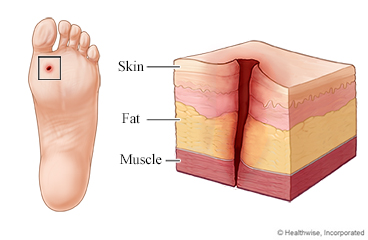
Overview
A puncture wound can happen anywhere on your child's body. These wounds tend to be narrower and deeper than cuts.
A puncture wound is usually left open instead of being closed. This is because a puncture wound can be easily infected, and closing it can make infection even more likely.
Your child will probably have a bandage over the wound.
The doctor has checked your child carefully, but problems can develop later. If you notice any problems or new symptoms, get medical treatment right away.
Follow-up care is a key part of your child's treatment and safety. Be sure to make and go to all appointments, and call your doctor if your child is having problems. It's also a good idea to know your child's test results and keep a list of the medicines your child takes.
How can you care for your child at home?
- Keep the wound dry for the first 24 to 48 hours. After this, your child can shower if your doctor okays it. Pat the wound dry.
- Don't let your child soak the wound, such as in a bathtub or kiddie pool. Your doctor will tell you when it's safe to get the wound wet.
- If your doctor told you how to care for your child's wound, follow your doctor's instructions. If you did not get instructions, follow this general advice:
- After the first 24 to 48 hours, wash the wound with clean water 2 times a day. Don't use hydrogen peroxide or alcohol, which can slow healing.
- You may cover the wound with a thin layer of petroleum jelly, such as Vaseline, and a nonstick bandage.
- Apply more petroleum jelly and replace the bandage as needed.
- Prop up the sore area on a pillow anytime your child sits or lies down during the next 3 days. Try to keep it above the level of your child's heart. This will help reduce swelling.
- Help your child avoid any activity that could cause the wound to get worse.
- Be safe with medicines. Read and follow all instructions on the label.
- If the doctor gave your child prescription medicine, give it as prescribed.
- If your child is not taking a prescription pain medicine, ask your doctor if your child can take an over-the-counter medicine.
- If the doctor prescribed antibiotics for your child, give them as directed. Do not stop using them just because your child feels better. Your child needs to take the full course of antibiotics.
When should you call for help?
Call your doctor now or seek immediate medical care if:
- Your child has new pain, or the pain gets worse.
- The wound starts to bleed, and blood soaks through the bandage. Oozing small amounts of blood is normal.
- The skin near the wound is cold or pale or changes color.
- Your child has tingling, weakness, or numbness near the wound.
- Your child has trouble moving the area near the wound.
- Your child has symptoms of infection, such as:
- Increased pain, swelling, warmth, or redness near the wound.
- Red streaks leading from the wound.
- Pus draining from the wound.
- A fever.
Watch closely for changes in your child's health, and be sure to contact your doctor if:
- The wound is not closing (getting smaller).
- Your child does not get better as expected.
Where can you learn more?
Go to http://www.healthwise.net/patientEd
Enter H937 in the search box to learn more about "Puncture Wounds in Children: Care Instructions".
Current as of: October 1, 2025
Author: Ignite Healthwise, LLC Staff
Clinical Review Board
All Ignite Healthwise, LLC education is reviewed by a team that includes physicians, nurses, advanced practitioners, registered dieticians, and other healthcare professionals.

